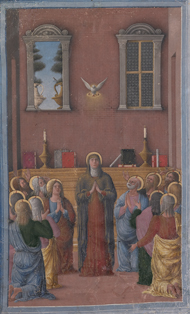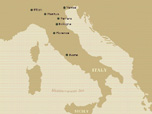 |

 |
 |
Initial G: Saint Blaise, Master of the Murano Gradual, about 1450–1460
Recent Acquisition
|
 |
 |
|
This exhibition explores Italian manuscript painting from the 1200s through the 1500s. It focuses on five centers of manuscript production in Italy, each with its own artistic traditions.
The journey begins in Bologna, site of the first European university, and ends in Rome, home to some of the greatest Renaissance works of art. Many illuminators moved from court to court throughout Italy to work for different patrons. The maker of this saint's portrait, known as the Master of the Murano Gradual, moved to Venice after being trained in Lombardy.
Saint Blaise has a craggy and hard-edged face, but his robe and the lines in the gold ground are refined and delicate. The saint was martyred with a wool carder's brush, the red object he holds in his hand.
|
 |
|
The city of Bologna was a major center of manuscript production in the 13th and 14th centuries. Legal textbooks and books for church services, prayer, and civic uses were made there.
This letter A from a choir book is ornamented with Christ on his throne in heaven. Christ's crisply modeled robe and piercing gaze give him a strong physical presence. Angels burst out of the letterform behind him, while the prophet Isaiah looks up at him from below.
This image accompanies a chant sung on the first Sunday of Advent, the season of preparation for Christmas.
|
 |
|
The small courts of northeastern Italy, such as Ferrara and Mantua, became important artistic centers in the 15th century.
This Pentecost by master illuminator Girolamo da Cremona probably comes from the city of Mantua. It has many similarities to the paintings of Andrea Mantegna, who also worked in Mantua.
Girolamo's work is distinctive for its meticulous detail, geometric precision, and decorative elements inspired by ancient Greece and Rome.
The expansive space and the symmetry of the composition make this a quintessentially 15th-century image.
|
 |

 |
 |
Initial B: Four Saints, Olivetan Master, about 1450
Recent Acquisition
|
 |
 |
|
|
 |
Lombardy, a region in northwestern Italy, was ruled by the dukes of Milan but maintained its own artistic traditions.
Lombard artists used the vibrant colors and long, thin figures of the International Gothic style well into the 1400s.
An air of religious reflection fills this portrait of four saints by the Lombard illuminator known as the Olivetan Master. The artist portrayed the saints as individuals by using different colors, facial types, and facial expressions. He also united them by giving them similar poses and gestures.
|
 |
|
The regions of Tuscany and Umbria in central Italy were home to many illuminators who also painted larger paintings on wood panels.
Lorenzo Monaco was the most celebrated late medieval painter and illuminator in Florence, the largest city in Tuscany. This image comes from a choir book and depicts Christ's last appearance on earth as he is taken up to heaven.
Because it was created in two phases 20 years apart, this illumination shows both medieval and Renaissance characteristics. Christ's robe reflects the International Gothic style of the late Middle Ages. The upright bearing and clearly defined ringlets of hair of the angel to his left reflect the style of the Florentine Renaissance.
|
 |

 |
 |
Initial A: King David, Matteo da Milano, about 1520
Recent Acquisition
|
 |
 |
|
|
 |
|
|
 |
Rome was the center of western Christianity, the seat of the pope, and a significant historical site. In the 1500s it attracted the most talented manuscript illuminators in Italy.
Matteo da Milano specialized in illuminated manuscripts for high-ranking clergymen from prominent families. This Initial A: King David was made for a member of the Orsini family and includes the family's coat of arms and images of little bears (orsini in Italian).
The border of the page boasts fanciful jewels, cameos, flora and fauna, and motifs inspired by ancient Greece and Rome.
This illumination is dramatically different from the one at the top of the page, reflecting the evolution of style in Italian manuscripts from the 1200s to the 1500s.
The exhibition is located at the Getty Center, Museum, North Pavilion.
|
 |







